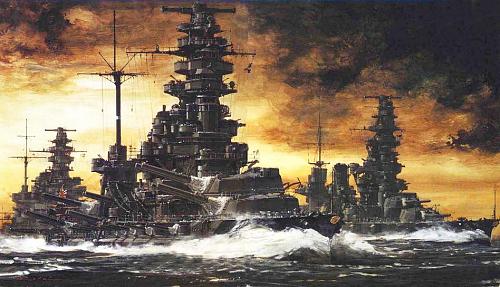
The Washington treaty system split IJN planners and doctrine into three competing factions. In assessing relative naval power in the 1930s, some in the IJN clung to an outdated formula that underlay the Washington treaties: counting capital warships of comparable displacement and gunnery power as the measure of fleet power. This ignored critical developments in aircraft carriers and general naval air power and in submarines, two ship classes in which the IJN was itself a leading innovator. This faction drove the decision to order two super battleships: the IJN Yamato, launched on December 16, 1941, and IJN Musashi, commissioned on August 5, 1942. In addition to super battle-worthiness, they and other armor and gun-engorged behemoths were meant to force the U.S. Navy to build matching ships that would be so large they could not pass through the Panama Canal, thereby in some sense dividing the American navy into discrete, and smaller, two-ocean fleets. Other naval officers formed a still more influential anti-treaty faction that griped angrily for two decades about the Washington treaty limits, insisting these were on Japan to leave her vulnerable with a weakened naval defense. This group wanted to break the Washington treaty limits not just in secret, as the IJN was already doing by the early 1930s, but to embark on an open naval arms race. The third faction was smaller. It belonged to the total war school, which saw a different type of war-fighting capability as partly obviating the need to match battlefleets with the Americans or British.
Interservice rivalry and differing Navy vs. Army views of who Japan’s main “hypothetical enemy” really was—the United States or the Soviet Union—meant IJN relations with the Imperial Japanese Army were openly hostile from 1936. The competition went far beyond the most severe interservice rivalries over budgets, influence, and prestige that are common to all militaries. It affected strategy, operational planning, weapons design, hoarding of oil and other strategic resources, economic competition, technical research, and virtually every other vital aspect of Japan’s ongoing war effort in China and future war in the Pacific. The pull on Japan by the Guandong Army into war for Manchuria in 1931, then more war in northern China from 1937, deeply frightened planners in the IJN. Their rather feeble effort to gain countervailing influence in Imperial Conferences was to base a small fleet on the Songhua (Songari) River in northern China. During the opening campaign of the Sino-Japanese War (1937–1945), the IJN was assigned to evacuate Japanese nationals from China’s coastal cities. It also supported its own Rikusentai, or marines, fighting for nine days in the streets of Shanghai, and flew air cover for the Army’s 50,000 man relief force. To interdict supplies to Jiang Jieshi, who was holed up in the southern interior at Chongqing, the IJN occupied Hainan Island and the Spratly Islands in 1939. That move was followed by an amphibious operation to land an expeditionary force on the south China coast, which moved inland to take Nanning. This coastal support role continued to the end of the war in China.
Doctrine and interservice rivalry aside, the Japanese economy was unable to sustain a capital warship building program that permitted fulfillment of the IJN’s vision of a battlefleet sufficient to defeat the Royal Navy in a “decisive battle,” let alone the more likely and generally hypothesized enemy, the U.S. Navy. The IJN kept pace with the Western powers in construction of submarines and carriers until just before war began in Europe in 1939. Its RO-class and larger I-class submarines were superior to any boats in the U.S. Navy; the I-class boats could cross the Pacific without refueling, an achievement denied to American submarines until after the war. The IJN looked to fall behind in quantity of warships of all classes as the USN received huge appropriations from Congress in 1940, while the Royal Navy expanded to meet the German threat in the Atlantic. The prospect of looming numerical inferiority in capital warships pushed IJN leaders closer to the idea of preemptive war against the Americans in the Pacific. Yet, even that prospect did not help the Japanese overcome U.S. shipbuilding capacity. From 1941 to 1945 the IJN would add 171 significant surface ships to its order of battle, about one-third the number of major surface ships launched by the USN over the same period. As the fight in the Pacific commenced, the IJN had the world¡¯s third largest battlefleet. Its Combined Fleet was the largest plying any single ocean. In December 1941, the IJN had 10 fleet carriers and 2,200 Japanese Naval Air Force planes, including over 500 flying boats and sea planes. However, it had only 2,500 Sea Eagles, or elite pilots, to fly them. It believed it had a two-year reserve of oil for its 10 battleships, 18 heavy cruisers, 20 light cruisers, 112 destroyers, 44 modern and 21 older submarines, and 156 smaller surface craft. Wartime consumption at higher than anticipated rates reduced that estimate to a one-year supply. Oil remained a critical problem in shaping IJN operations throughout the Pacific War, with lack of sufficient tankers a severely aggravating factor that ultimately led to a naval fuel crisis that could not be solved. The IJN equivalent to USN Seabees was the (‘senpaku kōhei rentai’) “Shipping Regiment” of naval engineers.